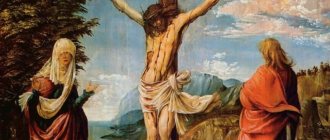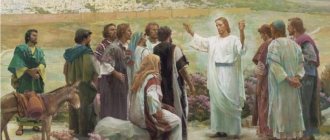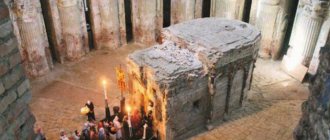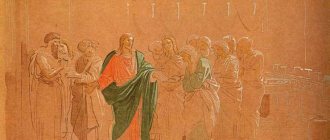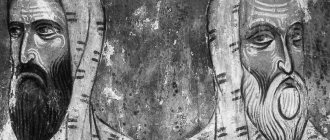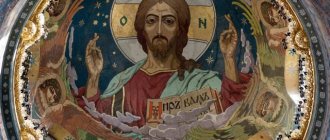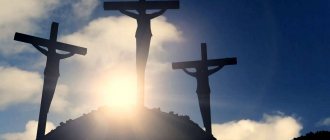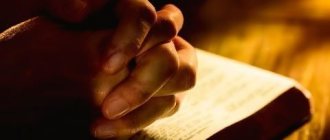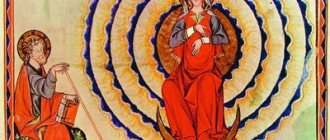Every Christian wears a cross as a sign that he believes in Our Lord Jesus Christ. At the same time, the cross in Ancient Rome was considered an instrument of painful and shameful execution - crucifixion. Criminals and slaves were crucified on the cross.
The Savior suffered the same fate. But his martyrdom became a victory over death, because it was followed by His Resurrection. Thus, having died for the sins of mankind, Christ, who had no sin, atoned for them and opened the gates to the Kingdom of Heaven for people, closed after the Fall of Adam.
The story of the execution of Christ is contained in all four Gospels
The crucifixion of Christ is described in all four Gospels. Thus, the evangelists report this: Matthew, Mark, Luke, John.
Moreover, all the Gospels paint before us almost the same picture of execution, with the exception of some details.
This suggests that they can be recognized as genuine evidence of the Savior’s atonement for Adam’s sin on the cross.
Three stages of the Passion of Christ: Exaltation to the Cross, Crucifixion, Descent from the Cross. 1645 Contribution of Tsar Mikhail Fedorovich. Cathedral of the Assumption of the Virgin Mary of the Kirillo-Belozersky Monastery. If you read all the Gospels, you can identify 18 episodes of the execution of Christ
If you study all four Gospels, you can identify 18 episodes of execution:
- The appearance of Jesus on Calvary (Matt. 27:33; Mark 15:22; Luke 23:33; John 19:17).
- Jesus' refusal to drink vinegar mixed with gall (Matt. 27:34; Mark 15:23).
- Nailing of Jesus to the cross between two thieves (Matt. 27:35-38; Mark 15:24-28; Luke 23:33-38; John 19:18).
- The first “word” of Jesus from the cross: “Father! forgive them, for they do not know what they are doing” (Luke 23:34).
- The soldiers who crucified Jesus divide His clothes (Matt. 27:35; Mark 15:24; Luke 23:34; John 19:23).
- The Jews slander Jesus and mock Him (Matt. 27:39-43; Mark 15:29-32; Luke 23:35-37).
- Jesus engages in conversation with two thieves (Luke 23:39-43).
- The words of Jesus addressed to the thief from the cross (second “word”): “Truly I say to you, today you will be with Me in Paradise” (Luke 23:43).
- The third phrase proclaimed by the Savior from the cross (third “word”): “Woman! Behold, Your son” (John 19:26-27).
- Darkness fell on the earth from three o'clock in the afternoon (Matthew 27:45; Mark 15:33; Luke 23:44).
- The cry of Jesus addressed to the Father (fourth “word”): “My God, My God! Why have you forsaken me? (Matt. 27:46-47; Mark 15:34-36).
- The fifth “word” of Jesus from the cross: “I thirst” (John 19:82).
- He drinks “vinegar of wine” (Matt. 27:48; John 19:29).
- The sixth “word” of Jesus from the cross: “It is finished!” (John 19:30).
- Jesus’ final cry (seventh “word”): “Father! into Your hands I commend My spirit” (Luke 23:46).
- Death on the cross is an act of Jesus' own will (Matt. 27:37; Mark 15:37; Luke 23:46; John 19:30).
- The veil in the temple is torn in two (Matt. 27:51; Mark 15:38; Luke 23:45).
- Confession of the Roman soldiers: “Truly He was the Son of God” (Matthew 27:54; Mark 15:39).
18
there are so many episodes of the execution of Jesus Christ
A brief retelling of the story of the crucifixion of Jesus Christ is known to every Christian
Every Christian is obliged to know briefly the history of the crucifixion of Jesus Christ. The fact is that this event, as well as the death and subsequent Resurrection of the Savior, are the cornerstones of the Christian faith.
Christ, by his death on the cross, atoned for the original sin of humanity, which Adam brought into the world. Having resurrected, he opened the gates to the Kingdom of Heaven that were closed because of this sin. Orthodox Christians remember this every time during Holy Week.
Christ before Caiaphas. N. P. Shakhovskaya. Mosaic of the Church of the Resurrection of Christ (Savior on Spilled Blood). Con. XIX century. Russia. Saint Petersburg. At the beginning, the cause of Christ was considered by the high priest of Judea, Caiaphas. It was he who came up with the idea of executing the Savior
The sorrowful path of Jesus to Golgotha begins with his betrayal by Judas. After He was captured at the word of the traitor, He was brought to Annas, the father-in-law of the high priest Caiaphas. After the interrogation of Christ by Annas, Jesus was sent for interrogation to Caiaphas, where the Sanhedrin sought His guilt.
Despite the fact that Pontius Pilate did not find Christ guilty, he approved the death sentence.
The high priest accused the Savior of blasphemy, and since this crime lay outside his jurisdiction, he sent Jesus to Pontius Pilate, the Roman governor of Judea at that time.
"What is truth?" (Christ and Pilate). Nikolai Ge, 1890. Despite the fact that the Roman governor of Judea, Pontius Pilate, did not find Christ guilty, he approved the death sentence of the Sanhedrin
Pontius Pilate did not find Christ guilty, but he was forced to confirm the verdict of the Sanhedrin and sentence the Savior to death by crucifixion.
He also failed to free Him in honor of the Passover holiday, since the Jewish people and the high priests demanded that the robber Barrabas be released in his place.
Sanhedrin
(ancient Greek) judicial council of elders
It must be remembered that Pontius Pilate, trying to avoid the fact that the Son of God would be condemned by him, sent him to the king of Galilee, Herod Antipas, who did not make any decision. At the same time, in mockery, he ordered Christ to be dressed in white clothes - a symbol of innocence.
Thesis 2: Christ’s entire human life was full of suffering.
At Golgotha, Christ’s suffering reached its highest point, its utmost tension and acuteness. But the Savior bore the punishment of our world (Isaiah 53:5) long before Calvary. In a sense, His entire human life was a series of more or less painful sufferings. The sacrifice of Christ began to take place at the very moment when God - limitless, omnipotent and impassive, that is, not involved in any suffering - became a Man and entered our limited, sick and full of suffering world.
Jesus was still a tiny baby - and the Jewish king Herod had already begun to pursue Him, so the Mother of God and Joseph the Betrothed had to hastily flee with Him to Egypt. During his adolescence, Jesus, the almighty God who controls everything from the birth of new stars to the smallest chemical reactions in the human brain, humbly submitted to His Mother and His named Father Joseph. Having gone out to preach at the age of thirty, He was constantly surrounded by people who sought from Him either healings, instructions, or food, and He was so exhausted that He fell asleep as soon as the slightest opportunity arose to rest, even on board a boat in a stormy lake (see ., e.g. Mark 4:38). As a Man, He suffered from hunger - let us remember the Savior’s forty-day stay in the desert, where He fasted and finally became hungry (Matthew 4:2). He also suffered from thirst - let us remember how, tired from the journey, Christ sat down to rest at a well and asked for water from a Samaritan woman (John 4:6-7). He was a wanderer, and He spoke of Himself like this: foxes have holes and birds of the air have nests, but the Son of Man has no place to lay his head (Matthew 8:20). He was sincerely compassionate when faced with human grief: he took pity on the widow from the city of Nain, whose only son died (Luke 7:13); he shed tears at the tomb of Lazarus, whose family he knew well and often visited (John 11:35). Let us pay attention: the Savior knew perfectly well that in a moment He Himself would bring both of them back to life—the son of the Nain widow and Lazarus. And yet he had compassion for people in their grief. Knowing what will happen does not exclude grief over what is.
The Savior also knew that a traitor was walking next to Him, and this was an additional and severe mental torment for Him: He, Almighty, grieved over what was happening in the soul of Judas and the impossibility of helping the disciple repent (although all attempts were made)…
And when the hour came, Christ - Almighty God, who even humanly knew how, when necessary, to pass among His offenders and avoid reprisals (Luke 4: 29-30), - gave Himself into the power of the leaders of Jewish society - the high priests, scribes and elders . Voluntarily endured humiliation, beatings, and bullying. And in the end, he was killed.
As the Apostle Paul succinctly put it: Christ, for the joy that was set before Him, endured the cross, despising the shame (Heb. 12:2).
Christ was crucified on Golgotha because it was a place of execution (place of executions)
After the Sanhedrin pronounced its verdict, and Pontius Pilate confirmed it, Christ was brought to Calvary.
On this path, the Savior endured many mockeries, as well as scourging. They executed Him on Mount Golgotha. There is an icon that depicts the plot of the execution on Golgotha.
Golgotha - translated this name means skull.
The hill was named so because of its shape or because the unburied skulls of those executed lay on it. In addition, theologians claim that the skull of Adam and his other remains were kept in this mountain.
Thus, Christ was crucified in the place where the first man on Earth, who brought original sin to humanity, rested.
Climbing the Cross. Russian icon, 16th century. The icon depicts the head of Adam, above which a cross is erected, on which Jesus Christ is executed
The Lord himself carried the instrument of his execution - the cross to the place of execution (place of executions). At Golgotha, Christ refused to take an intoxicating mixture of sour wine and myrrh. The fact is that He was tried and executed according to Jewish law, and He demanded that those executed be provided with this mixture to alleviate their suffering.
Thus, Christ showed that he was ready to endure all suffering and did not demand their relief, since he voluntarily accepted human sins.
Jesus Christ refused to take an intoxicating mixture of wine and myrrh before his execution.
The crucifixion of Jesus Christ was accompanied by the tortures inflicted on Him by Roman soldiers. The Savior showed no signs of anger or aggression.
He prayed for his tormentors and said: “Father! Forgive them because they don’t know what they are doing.” This happened during the crucifixion.
Pordenone. Crucifixion of Christ. (1520 - 1522). Cremona. Cathedral. Together with Christ, two robbers were executed. At the same time, on a tablet nailed to the crucifixion post, Pontius Pilate wrote: “Jesus of Nazareth, King of the Jews.”
Two thieves were crucified with Christ. One was hung on the cross on his right side, and the other on his left. Thus the prediction of the prophet Isaiah was fulfilled, who said:
“And he was numbered among the villains.”
(Isa. 53, 12)
The tablets that were nailed to the pole above the heads of the crucified usually indicated the guilt of those executed. Pontius Pilate ordered to write on it in Hebrew, Greek and Roman:
"Jesus the Nazarene King of the Jews."
Therefore the chief priests came to Pilate and said:
“Do not write: King of the Jews, but write that He said: I am the King of the Jews.”
But Pilate replied:
“What I wrote, I wrote.”
After the crucifixion, Jesus Christ experienced torment and humiliation
When Jesus Christ was crucified, Roman soldiers began to divide his clothes. They divided the clothes by casting lots, since Christ’s tunic consisted of a solid piece of woven, unstitched fabric. They tore the outer garments into four pieces according to the number of executioners.
Warriors cast lots for the vestments of the Lord. Monastery of Dionysiatus, Athos. After Christ ascended to the cross, the Roman soldiers cast lots to divide His garments
While the crucified Jesus was suffering cruelly, his enemies mocked him. The chief priests, scribes, elders and Pharisees mocked and said:
“He saved others, but he cannot save himself. If He is the Christ, the King of Israel, let him now come down from the cross so that we can see, and then we will believe in Him. Trusted in God; let God deliver Him now, if He pleases Him; for He said: I am the Son of God.”
Pagan warriors and other enemies of Christ followed their example.
Together with Jesus, 2 thieves were crucified on Golgotha.
One of the thieves crucified with Christ also began to slander, reproaching Jesus for being unable to save himself and them. Another prudent robber answered him, pointing out that they were condemned fairly, but the Savior had not done anything wrong.
He also asked Christ to remember him in the Kingdom of Heaven. To this Jesus replied: “Truly I tell you, today you will be with Me in Paradise.”
A prudent robber. Fragment of an icon. During the execution, one of the thieves crucified with Christ repented and the Savior took him with him to heaven
The enemies of Christ, in order to intensify his torment, brought his loved ones and relatives to the place of execution. At the cross of the Savior stood His Mother, the Apostle John, Mary Magdalene and several other women who revered Him.
Here the Savior instructed the Apostle John to take care of the Mother of God, which he did, taking her into his home and caring for her until his death.
Prayer to the Lord Jesus crucified
Lord Jesus Christ, Son of the living God, Creator of heaven and earth, Savior of the world, here I am, unworthy and most sinful of all, humbly bowing the knee of my heart before the glory of Thy Majesty, I sing praise to the cross and Thy suffering, and thanksgiving to Thee, the King of all and God, I offer, as you have deigned to bear all the labors and all kinds of troubles, misfortunes and torments, like a man, so that you will all be our compassionate Helper and Savior in all our sorrows, needs and embitterments. We know, Omnipotent Master, that all this was not needed by You, but for the sake of human salvation, that You might redeem us all from the cruel work of the enemy, You endured the Cross and suffering. That I will repay Thee, O lover of mankind, for all that Thou hast suffered for me for the sake of a sinner; We don’t know, for soul and body and all that is good are from You, and all that is mine is Yours, and I am Yours. Just in Your innumerable Lord, I trust in Your mercy, I sing Your ineffable long-suffering, I magnify Your inscrutable exhaustion, I glorify Your immeasurable mercy, I worship Your most pure Passion and, lovingly kissing Your wounds, I cry out: have mercy on me, a sinner, and make me not barren in I receive Your Holy Cross, so that by sharing Your sufferings here with faith, I may be worthy to see the glory of Your Kingdom in heaven! Amen.
Prayer to the Holy Cross
Save, O Lord, Thy people, and bless Thy inheritance, granting victories to Orthodox Christians against the opposition, and preserving Thy residence through Thy Cross.
Troparion to the Lord Jesus Christ crucified
Tone 1 Save Thy people, O Lord, and bless Thy inheritance, granting victories against resistance and preserving Thy life through Thy Cross.
The death of Christ was accompanied by great signs
The Crucifixion of the Lord was accompanied by great signs. From the hour of the day when the Savior was crucified, that is, from noon (sixth hour), the sun darkened and darkness fell throughout the entire earth and lasted until the third hour of the day (ninth hour), that is, until the death of the Savior.
Matthias Grunewald, Isenheim Altarpiece (1513 - 1515). Colmar. Unterlinden Museum. Before his death, Jesus Christ said: “My God, My God! Why have you forsaken me?
Around the ninth hour, Jesus Christ loudly exclaimed:
"Or or! Lama sabachthani! - My God, My God! Why have you forsaken me?
These are the opening words from King David’s 21 Psalm, in which David clearly predicted the Savior’s suffering on the cross.
This dying cry caused a wave of new ridicule of the Savior from his enemies.
Jesus Christ died around the ninth hour or three o'clock in our time.
Anticipating his death and suffering from thirst, Jesus said “thirst.” After this, one of the Roman soldiers put a sponge on his spear and, moistening it in vinegar, brought it to His lips. After this the Savior said:
"It is finished"
that is, the promise of God was fulfilled, the redemption of the human race and its reconciliation with God through the death of the Messiah was accomplished.
After this He said in a loud voice:
“Father! into Your hands I commend My spirit.”
And, bowing his head, he gave up his spirit.
This is what the curtain that separated the Holy of Holies looked like. After the death of Christ, it was torn into two parts as a sign that from now on there is no barrier between God and man
At this time, the Veil in the Temple, which covered the Holy of Holies, was torn in two, which symbolizes the termination of the Old Testament and the beginning of the New Testament.
In addition, the death of Jesus Christ was accompanied by an earthquake and the resurrection of the dead, who entered Jerusalem and appeared to many of its inhabitants.
At the same time, the centurion Longinus, who led the execution, as well as his soldiers, were frightened when they saw all this and began to say: “Truly, this man was the Son of God.” The people began to disperse, beating their chests.
The enemies of Christ did not believe in his Divinity and placed guards at his tomb
Since Friday evening is the time when Jews need to eat Passover, the Jews decided not to leave the bodies of those crucified on the crosses until Saturday. The fact is that Saturday was considered a great day.
Since the person being executed on the cross could suffer for a long time, the Jews asked Pontius Pilate to break their legs so that the condemned would die faster.
This is what they did with the robbers, but when they approached Christ, they saw that he had already died, so they did not break his legs. Another prophecy came true, which read:
“...not one of His bones will be broken.”
(Exodus 12:46; Numbers 9:12)
Unknown master of the Danube school from the workshop of Jörg Bray the Elder Crucifixion of Christ (after 1502). Esztergom. Christian Museum. In order to make sure of the death of Christ, one of the pagan soldiers pierced him with a spear.
Despite the obvious signs of death, one of the Roman soldiers pierced His ribs with a spear, and blood and water flowed from the wound. Thus was another prophecy about Christ fulfilled:
“They will look to Him whom they have pierced.”
(Zechariah 12:10)
Next, one of the Lord’s secret disciples, Joseph of Arimathea, received permission from Pilate to remove the Savior’s body from the Cross and bury Him.
Therefore, he, together with Nicodemus (another secret disciple of Christ), the Mother of God, John the Theologian and women devoted to the Lord, prepared Him for burial, transferring His body to the burial cave, which was located in the garden, which belonged to Joseph.
Burial cave of Christ. After the death of the Savior, His secret disciple Joseph of Arimathea received permission from Pontius Pilate to remove the body of Jesus and bury Him in his burial cave.
Since the high priests, scribes and elders were afraid that the apostles might steal the body of their Teacher in order to later announce His resurrection, they rolled a large stone at the entrance to the burial cave.
In addition, the Sanhedrin assigned a guard to the cave. The entrance to it was sealed. Thus ended the story of Christ’s crucifixion and began the story of His resurrection.
Links
Places Garden of Gethsemane • Sanhedrin • Golgotha Jesus and disciples Jesus Christ • Virgin Mary • Mary Magdalene • Mary of Cleopas • John the Theologian • Apostle Peter • Apostle Mark • Judas Iscariot • Myrrh-Bearing Women Jews Herod Antipas • Caiaphas • Annas • Malchus • Servant the Doorkeeper • Barabbas • Simon of Cyrene • Ahasuerus • The Prudent and the Mad Robbers Romans Pontius Pilate • Claudius Proculus • Centurion Longinus Items Instruments of the Passion: Crown of Thorns • Robe of the Lord/Seamless Chiton • Life-Giving Cross • Titlo INRI • Spear of Longinus • Holy Grail • Thirty Pieces of Silver Iconography Ecce Homo • Shape of the cross of Jesus Christ • Crucifixion (decorative arts) Personalities Saint Joachim and Saint Anna • Righteous Elizabeth • Joseph the Betrothed • Jesus Christ • John the Evangelist Places and objects Jerusalem • House of Joachim and Anna (Orthodox, Catholic) • Second Temple • Nazareth • House of Our Lady of Loreto • City of Juda • Spring of the Virgin Mary • Bethlehem • Cave of the Nativity • Milk Cave • Mataria • El Minya • Cana of Galilee • Zion's Upper Room • House The Virgin Mary in Ephesus • House of St. John the Evangelist • Tomb of the Virgin Mary • Robe of the Virgin Mary • Belt of the Blessed Virgin Mary • Lot of the Virgin Mary Iconography Orthodox • Catholic • Iconography of the Life of the Virgin Mary Dogmas and holidays Feasts of the Virgin Mary • Immaculate Conception of the Virgin Mary • Praise of the Blessed Virgin Mary • Protection of the Blessed Virgin Mary • Cathedral of the Blessed Virgin Mary • Blessed Virgin Mary, Queen of Poland Prayers Ave Maria • Hymn to the Blessed Virgin Mary • Theotokos antiphons • Worthy to eat • Rejoices in You • Rosary • Litany of the Blessed Virgin Mary • Agni Parthena Related characters Martha and Mary • Lazarus of Bethany • Mary of Egypt Other Gospel of Mary • Holy Grail In popular culture The Da Vinci Code (novel) • The Da Vinci Code (film) • The Last Temptation of Christ • Jesus Christ Superstar This is a draft article about Christianity. You can help the project by adding to it.
Christ was executed on the cross to humiliate Him
Many believers and non-believers ask: how was Jesus Christ crucified? They crucified Him in the usual accepted way in Ancient Rome. The arms and legs were nailed to the post, while the arms were nailed to the crossbar of the crucifix.
The cross was chosen as an instrument of execution because crucifixion in Ancient Rome was considered a common form of punishment to which slaves and the most notorious criminals were doomed. That is why it is easy to answer the question: who was crucified with Jesus? These are robbers.
Execution of slaves who participated in the Spartacus uprising. Engraving. In ancient Rome, death on the cross was considered shameful. It was used against the most notorious criminals, for example, rioters. This is why Christ was crucified
It should be noted that according to Jewish law, a person hanged from a tree was considered cursed. The Jewish leaders wanted to disgrace Jesus Christ forever by condemning Him to such a death. But why was Jesus crucified on the cross?
In order to answer this question, you need to know why the Savior was crucified. According to the verdict of the Sanhedrin, approved by Pontius Pilate, Christ was executed for blasphemy and incitement to rebellion. These are serious crimes in Ancient Rome, hence the choice of execution weapon.
In art
A distinctive feature of the image of the Crucifixion in the Catholic tradition is that both feet of Christ are crossed and pierced with one nail.
In the Orthodox tradition, Christ is depicted crucified on four nails: both hands and feet are nailed, each with its own nail. Also on the Crucifixion in the Orthodox tradition, the palms of Christ are necessarily depicted open. The question of the inadmissibility of depicting the bent fingers of Christ under Catholic influence was raised in 1553 by the clerk Viskovaty and, although the clerk was condemned for talking about icon painting, the arguments about the need to depict open palms were recognized as correct and the controversial icons were rewritten. The sculptural image of the crucified Christ (see Crucifixion) is a traditional attribute of the decoration of Western churches; in the Orthodox Church, carved wooden crucifixes (sometimes with standing ones) are traditionally used in churches.
The icon “Crucifixion of Christ” depicts the main symbols of faith
The icon of the Crucifixion of Christ is popular in the Orthodox world. The fact is that the main symbols of faith are usually placed on it. At the same time, works created before the period of iconoclasm are characterized by the depiction of the following minor characters on the icon:
- The Mother of God is most often on the right side of the Savior; John the Theologian - one of the 12 apostles and 4 evangelists, on the other side of the cross;
- two robbers crucified side by side on each side, Rach, who believed right on the crucifixion, became the first person saved by Christ and ascended to heaven;
- three Roman soldiers - located in front from below, as if under a cross.
The figures of robbers and warriors are often depicted smaller than others in size. This emphasizes the hierarchy of the characters present, determining which of them is of greater importance.
Crucifixion of the Lord. Icon around 1497. The icon depicts: the Savior, the Mother of God, angels, John the Theologian, Longinus the centurion. Under the base of the crucifix lies the skull of Adam, which symbolizes the atonement of his sin by Jesus Christ's death on the cross
People who feel their own sins most often turn to the Crucifixion icon with prayers. If you realize that you have committed a sin and want to become red-hot, you can turn to this image. He can not only help, but also strengthen you in faith and guide you on the true path.
By leaving a comment, you accept the user agreement
